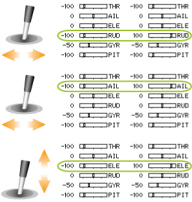Difference between revisions of "Manuals:MBPlusFblV52:Radio System"
Shornstein (talk | contribs) (Copied from Manuals:MBPlusFblV5:Radio System, revision 14094) |
Shornstein (talk | contribs) |
||
| Line 2: | Line 2: | ||
<translate> | <translate> | ||
<!--T:1--> | <!--T:1--> | ||
| − | {{TOC_MBPlusV5|Manuals: | + | {{TOC_MBPlusV5|Manuals:MBPlusFblV52:Hardware_Installation/en|Manuals:MBPlusFblV52:ReceiverType/en2}} |
{{DISPLAYTITLE:Radio system|noerror}} | {{DISPLAYTITLE:Radio system|noerror}} | ||
__TOC__ | __TOC__ | ||
Revision as of 12:36, 25 September 2020
Preparing the transmitter
You can use nearly any transmitter that provides at least 6 channels. By default 5 channels are used for controlling MICROBEAST PLUS and one channel controls the motor. If using additional features like AttitudeControl or RPM Governor a receiver with single wire output and more channels may be useful to have, but this is not a must.
- Create a new model in your radio‘s model memory.
- Never enable your radio‘s eCCPM mixing function! Disable any mixing functions for the swashplate or rudder. Each function should be assigned to just one receiver channel. All the swashplate mixing will be done by MICROBEAST PLUS. Set your radio‘s swash mixer to mCCPM (mechanical mixing) which is often called “H1”, “1 servo” or “normal“ mixing or disable “swash mixing” if applicable.
- Be sure that all trims and sub trims are disabled and that all servo travels are set to 100% in any flight mode. There mustn't be any active mixing functions (for example rudder revo-mixing). Have a look at the radio’s servo monitor: each stick has to control one channel/servo output (except for thrust stick which typically controls collective pitch and motor). Note when using MICROBEAST PLUS you do not directly control the servos of the helicopter. By moving a stick you give a control command to the system which then performs the necessary servo movements to move the helictoper in the commanded direction. Each control command is bound to one servo output channel of the transmitter.
- Also do not adjust the collective pitch curve at the moment. For the setup procedures it has to be set as a straight line reaching from -100% to +100% (or 0 to 100% depending on radio brand).
- Other functions such as throttle curves, ESC switches or auxiliary functions can be adjusted as usual. But especially for the throttle make sure you can disable the throttle channel and separate it from the collective stick movement for performing the setup. You can do this by using the HOLD switch on the radio or by setting the throttle curve to a flat 0% line. Also it is advisable to create different flight modes for different flight states/rotor headspeeds.
Make sure that the motor in electric models can not start when doing the adjustment work! If the drive battery is used as power supply for receiver, servos and MICROBEAST PLUS disconnect the motor from the ESC.
Receiver installation
MICROBEAST PLUS can work with a lot of different receiver types and radio brands and especially with different types of signal protocols. Depending on which signal protocol you intend to use for controlling the MICROBEAST PLUS the wiring layout may vary. In the following you can see all supported protocols and specific wiring scheme for each receiver type. Ensure a tight fit of the connectors. The pin board of MICROBEAST PLUS is designed so that the plugs firmly clamp each other when they are fully inserted. Anyhow, especially when using a receiver with single wire output it is possible that connectors are plugged in with no adjacent neighbors. Such plugs should additionally be secured against loosening.
Standard receiver
A conventional receiver with multiple servo output connectors is what we consider a "Standard receiver". Here you connect each servo output to one specific control function at the MICROBEAST PLUS using one connection wire for each function. You have these 5 input functions (wires): Aileron, Elevator, Rudder, Collective pitch and gyro gain. Simply connect each wire to the corresponding channel output port at the receiver which you like to use for the specific function. If you don't know which stick controls which channel have a look at your radio's servo monitor, refer to your radios instruction manual or simply connect a servo to each channel testwise!
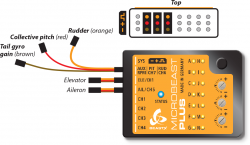
|
Here we show connection layouts for two common radio brands. Note that this is only exemplary, the channel output of your transmitter can by different even when using a radio of this brand. And you can use any other radio system on the market together with MICROBEAST PLUS when using the servo output channels of the receiver, not only these two brands!

|

|
- The wires for rudder, pitch and gyro are signal wires. They must be placed on the same receiver side as the the both orange wires from aileron and elevator!
- You must connect all 5 functions/wires to the receiver. When you do not connect all wires the system will not finish initialization sequence!
- The throttle servo/speed controller is connected to the receiver's throttle output. Using the Governor function of MICROBEAST PLUS therefore is not possible in combination with a Standard receiver.
Receivers with single wire output (single-line receivers)
With a single-line receiver all channels (control functions) are transmitted by one single connection wire to MICROBEAST PLUS. This is done by packing all channel output data to a data paket or by chaining the servo signals to one output port. At the moment MICROBEAST PLUS supports the following systems: Multiplex® SRLX, Spektrum® SRXL, Futaba® SBus, JR® X-Bus(B), Jeti® UDI, Jeti® EXBus, ALIGN® iBus, FlySky® iBus, Graupner HOTT® SUMD, SPPM
There are single-line receivers available that supply additional single channel connectors/servo outputs. In combination with MICROBEAST PLUS you only have to treat such receivers as single-line receivers if you really use the single-line function. If you connect the receiver by using the standard 5-plug layout, such receiver has to be considered as Standard receiver in the following and as shown above.
- The single-line connection wire is plugged into the [DI1] input of MICROBEAST PLUS
- The throttle servo or ESC is connected to the [CH5] output. When using a speed controller with BEC, from here the power will be distributed to receiver and servos.
- Alternatively or additionally you can connect a power supply/second BEC wire/buffering battery to the [SYS] port and to the receiver (in case this has additional servo or battery ports).
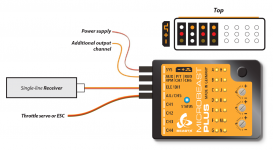
|
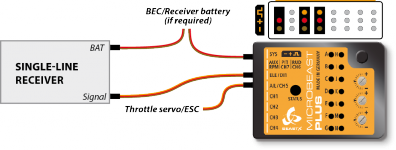
|
| Wiring layout for single-line receivers | Alternative wiring layout for single-line receiver with additional servo output channels |
When using a big heli with standard size servos it may be insufficient to only provide power at the [SYS] port or receiver. Note when only connecting power at the receiver, all the current has to flow over one thin wire to the servos! If there are no other ports left to (additionally) feed in power, we highly recommend using the MICROBEAST PLUS HD which has an additional high power input to reduce wiring resistance and to serve todays demands for a robust servo power supply.
Spektrum® DSM/JR® DMSS remote satellite
A special type of single-line receiver is the remote satellite. These receivers are usually used as additional receiving unit in combination with a (bigger) main receiver to provide a more robust and fail safe radio system. But also you can directly connect one of such receivers to MICROBEAST PLUS to achieve a small and light weight radio system to be used in small sized rc models. MICROBEAST PLUS supports the following systems: Spektrum® DSM2, Spektrum® DSMX, JR® DMSS. The remote receiver can be directly connected to the small sized white pin board at the side which will provide a stabilized voltage of 3.3 Volts which is necessary to power these receivers. Alternatively if you have the optional available Spektrum® satellite adapter (Order Nr. BXA76009) also you can connect the receiver at the front to the [DI1] port, just like any other single-wire receiver, so you can keep the pin board free for connecting a sensor.
Please note: MICROBEAST PLUS does not support connecting more than one remote satellite at a time!
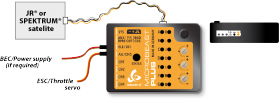
|
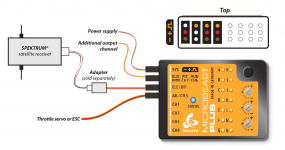
|
| JR®/Spektrum® remote satellite connected at side pin board | JR®/Spektrum® remote satellite connection with power adapter |
When using a speed controller with BEC, the power will be distributed from [CH5] input to receiver and servos. Alternatively or additionally you can connect a power supply/second BEC wire/buffering battery to the [SYS] port.
Using a remote satellite is only recommended for small rc modells like helicopters of 450 size or smaller. Due to the design one single receiving unit is more prone to radio interference and can result in reduced transmission range.
Receiver binding
Before using your receiver with MICROBEAST PLUS make sure that the receiver is bound to the transmitter and that it is sending output data on the servo outputs and/or single-line port. Please refer to the manual of your radio system to find out how binding procedure is performed with your specific system. Also check if there is the need to perform special settings to enable the single-line data output of the receiver in case you intend to use this output port in combination with MICROBEAST PLUS.
Only in the case of using a single Spektrum® remote satellite receiver directly connected to MICROBEAST PLUS you must bind the receiver by the aid of MICROBEAST PLUS as there is no other option to enable binding procedure at the receiver. Please note that it is very important to bind the receiver first before programming MICROBEAST PLUS and this step must be performed, even if the satellite was already in use and already bound to the transmitter earlier (e. g. in connection with a Spektrum® main receiver unit).
Watch out that the motor can not start accidentally when using the BEC of your speed controller to power the unit!
When initiating bind sequence you have to set whether you're using a DSMX or DSM2 satellite (the actual selected signal protocol in the transmitter is not relevant!). It is very important to choose the correct type of satellite receiver here, since an improper setting may seem to work but can lead to radio interference or total loss of radio linkage in the subsequent operation!
Insert a Spektrum® “Bind Plug” at the [SYS] port of MICROBEAST PLUS. In case the power is supplied exclusively at the [SYS] connection, to bind a Spektrum® satellite receiver the power supply must be provided temporarily through any of the other ports [CH1] - [CH5]. To bind a DSMX satellite simply switch on the power supply now. The LED on the receiver and LED H on MICROBEAST PLUS will start to flash. You can bind the transmitter as usual (for more information refer to the instructions of your radio control system). To select and bind a DSM2 satellite, hold down the button on MICROBEAST PLUS while switching on the power supply. Now the receiver‘s LED and LED N (!) on the MICROBEAST PLUS will flash. Release the button and bind the receiver with your transmitter. After successful binding procedure the receiver‘s LED will stay solid. LED H respectively N flash alternately to all other LEDs for 2 seconds, then MICROBEAST PLUS will enter receiver setup menu automatically as further setup steps may be required to use this type of receiver. Remove the bind plug and proceed with the setup as described in the following of this manual.
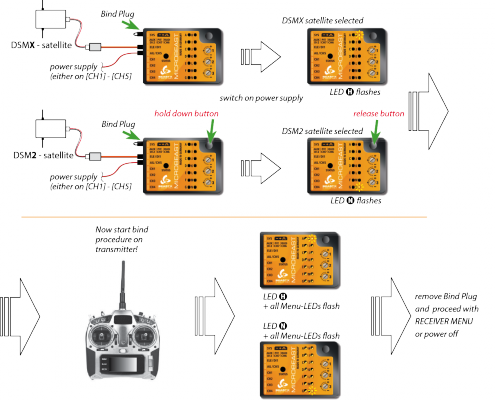
|
Note:
- Decisive for the selection alone is, which type of satellite receiver is plugged in! It is irrelevant which transmission method between the receiver and transmitter is actually used. Check carefully what type of receiver you have and what type you setup. An incorrect setting is not obvious but will lead to malfunction or failure of the radio link later in use.
- It makes no difference if you pull off the “Bind Plug” during the binding process or leave it connected as you would expect from some “standard” Spektrum® receivers!




